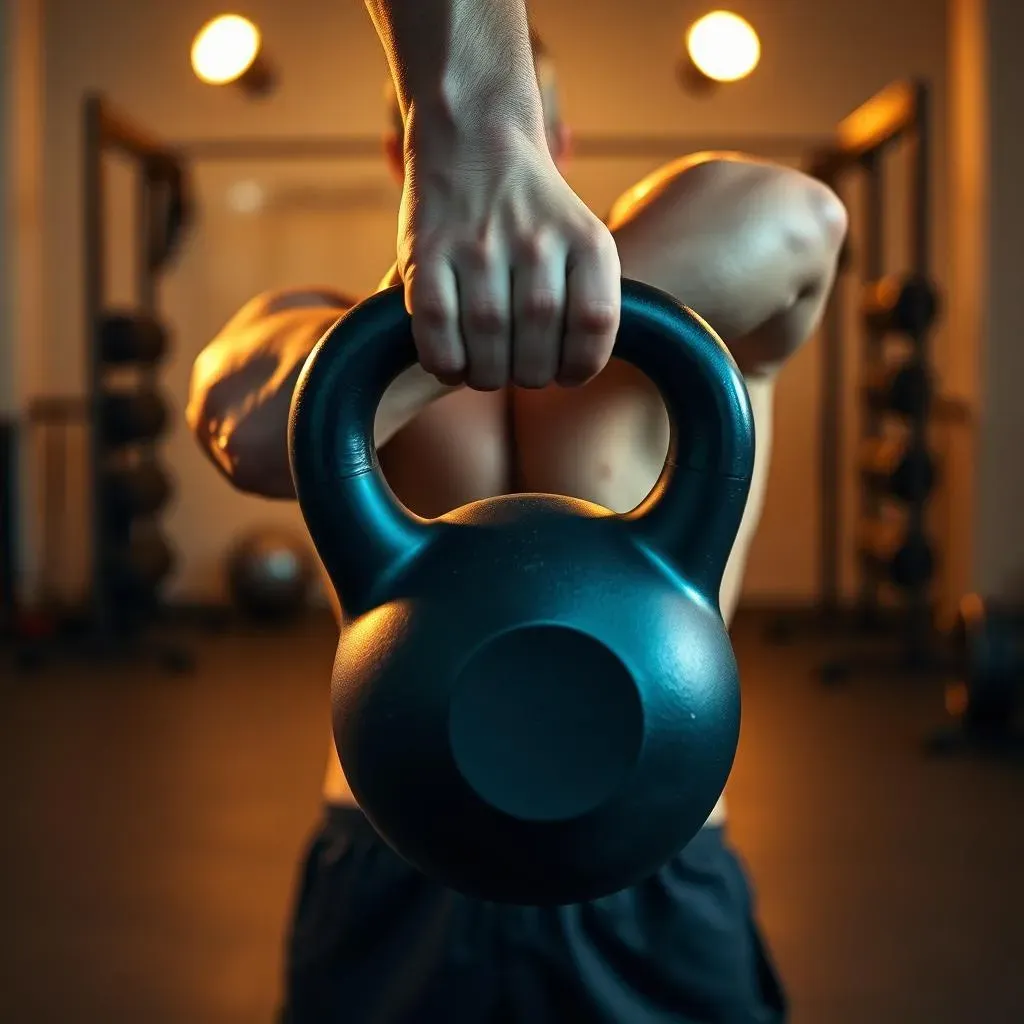Table of Contents
Ever felt that nagging ache in your lower back? You're not alone. Many of us spend hours hunched over desks, leading to weak and painful lower backs. But what if I told you that a simple tool could be your secret weapon against this common problem? That's where the kettlebell comes in. This isn't about becoming a gym rat; it's about building a stronger, more resilient lower back that supports you in everyday life. We're going to explore why a lower back workout kettlebell routine is so effective, and the best exercises to get you started. Think of it like this: your back is the trunk of a tree, and we're going to make it sturdy and strong. I'll walk you through the most effective kettlebell movements, how to put them together in a workout, and most importantly, how to do it all safely. Get ready to say goodbye to back pain and hello to a stronger you. Let's get started!
Why Your Lower Back Needs Kettlebell Love

Why Your Lower Back Needs Kettlebell Love
The Modern Back Struggle
Let's face it, our lives aren't exactly designed for back health. We sit for hours at desks, hunch over our phones, and then wonder why our lower backs feel like they're constantly staging a protest. This constant forward-bending posture weakens our back muscles, making them more susceptible to injury. It's like having a car with a rusty frame – it might look okay, but it's not going to hold up well over time. We need to strengthen those muscles to give our back the support it needs.
And it is not just about the pain either. A weak lower back can throw off your whole body, affecting your posture, balance, and even how you move around. It is all connected, and those little muscles in your back play a bigger role than you think.
Kettlebells: The Back's Best Friend
Now, why kettlebells, you might ask? Well, unlike machines that isolate specific muscles, kettlebell exercises engage your entire core, including your lower back. Think of it as a full-body workout disguised as a strength exercise. The dynamic movements require your back muscles to work hard to stabilize your body, which leads to greater strength and resilience. It's like giving your back a full-time job as a superhero, ready to take on any challenge.
Benefit | Why it Matters |
|---|---|
Core Engagement | Strengthens the back and abs together for better stability. |
Functional Movement | Mimics everyday actions, making you stronger for real life. |
Improved Posture | Helps you stand taller and feel more confident. |
More Than Just Strength
It is not just about building muscle; using kettlebells for your lower back workout can improve your overall movement. It is like teaching your body how to move properly again, undoing all that slouching we do. Better movement means less pain, more energy, and the ability to tackle daily activities without that annoying backache. The improved range of motion can also prevent future injuries. It’s a win-win.
It is not a quick fix, of course, but it is a powerful way to take control of your back health and feel better overall. It can be empowering to know that you're actively working to improve your body.
The Best Kettlebell Exercises for Lower Back Strength

The Best Kettlebell Exercises for Lower Back Strength
Alright, let's get to the good stuff – the actual exercises that will help you build a solid lower back. Forget those fancy machines; we're going back to basics with kettlebells. These aren't just random moves; they're carefully selected to target the muscles that support your lower back, helping you stand taller, move better, and feel stronger. I've personally tried these, and let me tell you, they work. We're talking about movements that will feel challenging, but not in a way that leaves you feeling broken. It's about building strength, not just showing off. Think of these exercises as your back's personal trainers, guiding it to be its best self.
Now, I know what you might be thinking: "Are these moves hard?". The good news is, they can be scaled to fit your fitness level. Start with lighter weights and focus on form. It's not a race to lift the heaviest kettlebell; it's a journey to a stronger back. And trust me, once you get the hang of these, you’ll feel the difference. We'll break down each exercise, and I'll give you some tips to make sure you're doing them safely and effectively. So, grab your kettlebell, and let's get moving!
The Power Moves
Here are some of the best kettlebell exercises for your lower back:
- Kettlebell Deadlifts: This is your bread and butter. It teaches you to lift with your legs, not your back, which is crucial for preventing injuries. Think of it as picking up a heavy grocery bag, but with intention and control.
- Kettlebell Swings: This isn't just a cardio move; it engages your entire posterior chain, including your lower back. It's like a dynamic plank, strengthening your core and back at the same time.
- Kettlebell Good Mornings: This one targets your lower back and hamstrings. It is like doing a bow, but with a kettlebell. Start with a light weight, and focus on keeping your back straight.
- Kettlebell Rows: You might think this is just for your arms, but it also works your back muscles, especially when you keep your core engaged. It's like giving your back a hug, but a strengthening hug.
Each of these exercises works a little differently, but they all share one thing in common: they make your lower back stronger and more resilient. It's not just about lifting weight; it's about moving in a way that supports your body and prevents future pain. So, incorporate these into your workout, and you'll start to feel the difference in no time.
Crafting Your Lower Back Workout with Kettlebells

Crafting Your Lower Back Workout with Kettlebells
Putting It All Together
So, you've got the exercises, but how do you actually create a workout? It's not about throwing a bunch of moves together and hoping for the best. We need a plan, like a recipe for a strong back. Think of your workout like building a house. You start with a solid foundation, then add the walls and the roof. In our case, the foundation is warming up your body, then we add the strength exercises, and finish with some cool-down stretches. It is not about going all out every time, it is about consistent progress.
Start with 2-3 sets of 8-12 reps for each exercise. It's better to focus on proper form than trying to lift the heaviest weight you can. If you're new to this, start with a lighter kettlebell, or even no weight at all, just to get the movements down. I remember when I first started, I was all over the place! But with time and practice, it gets easier. The key is to be patient with yourself and listen to your body.
Sample Workout Plan
Here's a sample plan to get you started. Remember, this is just a guide, feel free to tweak it as needed.
Exercise | Sets | Reps | Notes |
|---|---|---|---|
Kettlebell Deadlifts | 3 | 10 | Keep your back straight |
Kettlebell Swings | 3 | 15 | Engage your core |
Kettlebell Good Mornings | 2 | 10 | Use a light weight |
Kettlebell Rows | 3 | 10 per side | Squeeze your shoulder blades |
Listen to Your Body
The most important thing is to pay attention to how your body feels. If something hurts, stop. Don't push through pain, it's your body telling you something is wrong. It's like ignoring the check engine light on your car – it's not going to fix itself. Rest is just as important as the workout itself. Your muscles need time to recover and rebuild. Try to get enough sleep, eat nutritious food, and stay hydrated. It’s all part of the process. And remember, consistency is key. Don't expect to see results overnight. It's about making this a part of your regular routine, just like brushing your teeth or drinking coffee in the morning. Think of it as a long-term commitment to your back health.
I always say, "Progress, not perfection," and that rings true here. Each workout is a step towards a stronger, healthier you.
Avoiding Pain: Lower Back Kettlebell Safety Tips

Avoiding Pain: Lower Back Kettlebell Safety Tips
Listen to Your Body: The Golden Rule
let's talk safety, because nobody wants a tweaked back. The most important thing to remember is to listen to your body. If you feel a sharp pain, stop immediately. It’s not about being tough; it’s about being smart. Think of your body like a car. If the engine starts making a weird noise, you don't keep driving, right? You pull over and check it out. Same goes for your back. Don't push through the pain, it's your body's way of saying, "Hey, something's not right here!"
Also, start slow. Don't try to lift the heaviest kettlebell on your first day. It's like trying to run a marathon without any training – you're going to get injured. Start with lighter weights and focus on your form. Perfect form is more important than the amount of weight you lift. Quality over quantity is the name of the game. And if you're not sure about your form, don't be afraid to ask a trainer or someone who knows their stuff. It's better to be safe than sorry, and a little guidance can go a long way.
Form First, Weight Second
Proper form is your best friend when it comes to avoiding lower back pain. It's like learning how to write properly before trying to write a novel. If your form is off, you're not only going to get less out of the exercise, but you're also putting yourself at risk of injury. For example, when doing deadlifts, make sure you're hinging at the hips, not rounding your back. It's like doing a bow, not a hunch. And when you're doing swings, engage your core and use your hips to generate the power, not your back. It should feel like you're popping your hips forward, not yanking with your back.
It is also important to control the kettlebell during the exercises. Don't let it swing wildly. Think of it as a dance, where you're moving with the weight, not being dragged by it. And if you're not sure about your form, record yourself doing the exercises. It can be really helpful to see what you're doing from a different perspective. Sometimes what you think you're doing and what you're actually doing are two different things.
Safety Tip | Why It Matters |
|---|---|
Listen to Your Body | Avoids pushing through pain and causing injury. |
Start Slow | Prevents overexertion and strain on muscles. |
Focus on Form | Ensures proper muscle engagement and reduces risk of injury. |
Control the Movement | Prevents jerky motions that can strain your back. |
Wrapping Up: Your Stronger Back Awaits
So, there you have it – a straightforward guide to using kettlebells for a stronger lower back. It's not about overnight miracles; it's about consistent effort and proper form. Remember those key exercises like deadlifts, good mornings, and back extensions? They're your foundation. And always prioritize safety, it's not a race. If you're unsure, grab a friend or a trainer to check your form. This isn't about lifting the heaviest weight; it's about building a back that can handle whatever life throws at it, whether that's carrying groceries or chasing after kids. With a bit of patience and a little bit of sweat, you'll be well on your way to a healthier, happier, and stronger back. Now, go grab that kettlebell and get to work!